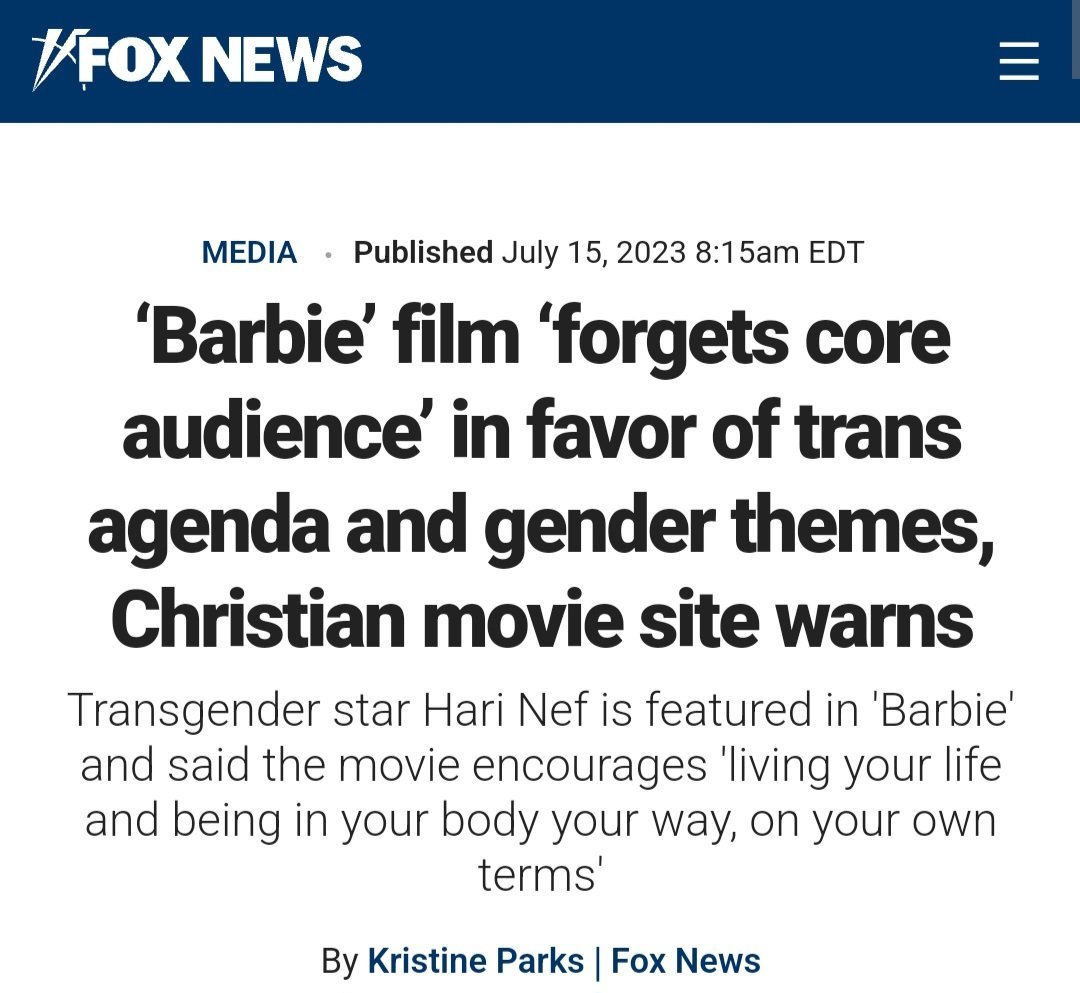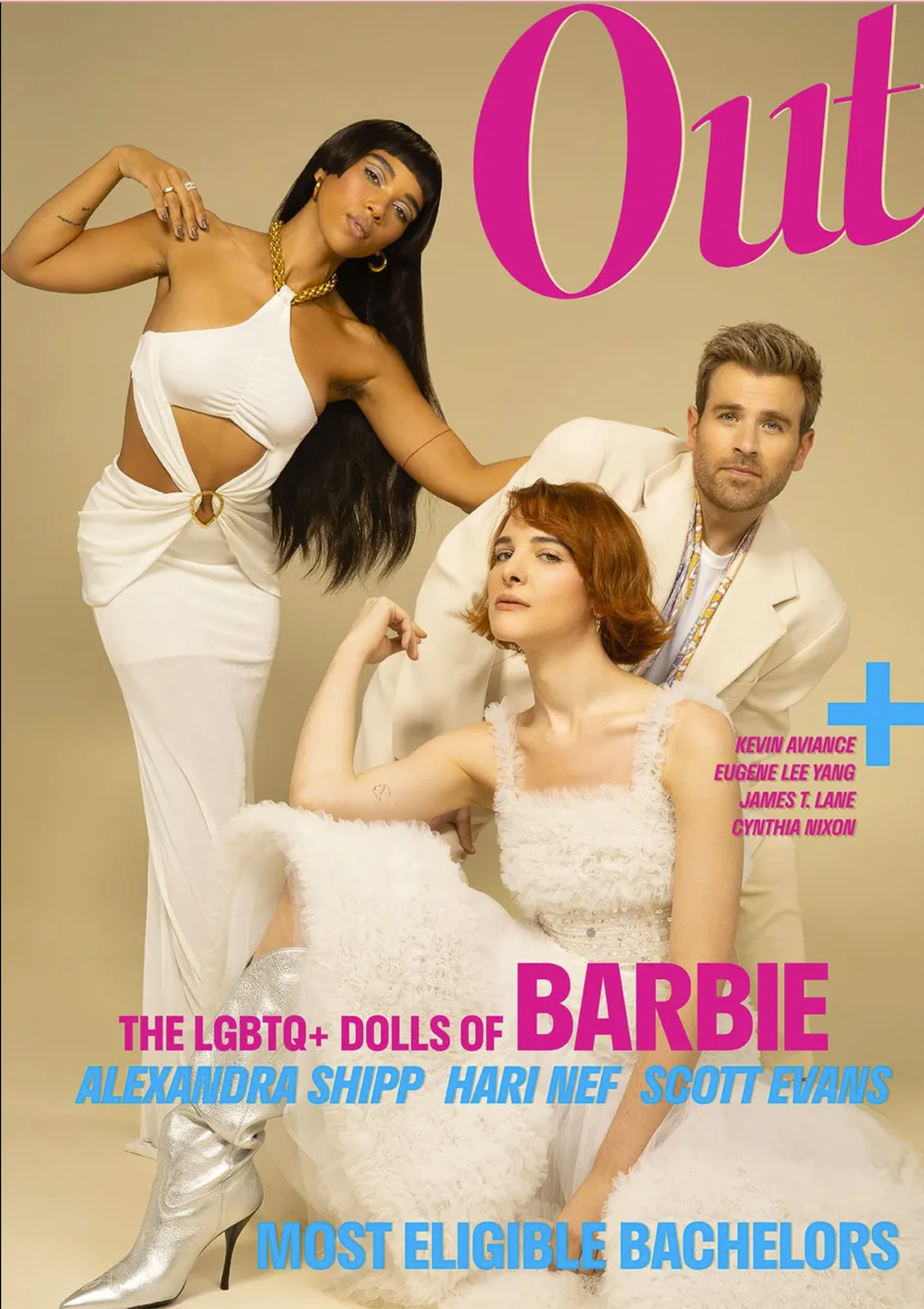Barbie and the gender wars
Note: This is part one of what will likely be a series, since as of right now, I’ve not had a chance to see the movie in question. I will be genuinely astonished if I have nothing to say afterwards, so for now, let’s call this part one? Please be warned that while much of this is light-hearted, it delves into themes that very much are not. It isn’t possible to talk about the history of the Barbie franchise with any seriousness without colliding into themes of misogyny and violence.
Yesterday I was genuinely tickled to read a Fox News headline warning about the dangers of the new Barbie movie. The headline was bolstered by a quote stating “the movie encourages ‘living your life and being in your body your way, on your own terms’”, and after giving it more than eight seconds consideration, I did what any rational adult would do and made fun of it on the internet. This was retweeted over four thousand times and seen by well over a million people… and the complaints have begun rolling in.
Like most people, I have a complicated relationship with Barbie. I was in the single digits in the 80’s, and in high school in the 90’s. I remember the first studies which came out showing how profoundly the franchise had accelerated already impossible beauty standards, amplifying an already out-of-control epidemic of disordered eating and body image challenges. I remember when someone sat down and did the math, from which several eating disorder specialists postulated that based on the proportions of her untenably long legs, tiny waist and enormous bust, she would have spinal problems before she was middle-aged.
The mythology and imagery of Barbie was as that of the quintessential popular girl, whose absurdly easy life as depicted in promotional materials pigeon-holed her into the newly minted archetype of “mean girl”. She was hated by feminists and misogynists alike for polar opposite, mutually-exclusive reasons. While feminists have rightly criticized the franchise for pushing impossible beauty standards and heteronormative ideas of family and femininity, the far-right has argued Barbie is a tool of progressive recruitment.
As Mattel has sought to keep up with criticism and maintain relevance for its flagship product, Barbie’s life has evolved from homebody and trophy wife, to pop star and highly-educated professional. The latter of which earned Barbie a place in the crosshairs of the evangelical movement, who accused her of persuading young girls to look beyond motherhood. Indeed, she did. Having briefly been a surgeon in the 1970’s, at the end of the 1980’s, Barbie became a primary care doctor. She was a pediatrician in 1995, just after her presidential candidate debut in 1992. However, despite her lavish palaces, private jets and designer wardrobe, Barbie’s professional aspirations have spanned socioeconomic strata. She’s worked in a variety of blue collar jobs such as fast food, grocery clerk, farmer and barista. In fact, her list of careers is so long that Wikipedia has an entire page dedicated to Barbie’s career history. According to Mattel, Barbie has served in every single branch of the American armed forces.
Barbie’s family life has also been nebulous and evolving. With no visible parents, she raised her younger sister Kit, and her nebulous marital status with Ken earned her the accusation of single-motherhood. In many ways, Barbie has existed since 1965 as a cultural tableau upon which every facet of the American mainstream has projected its own fears, aspirations and prejudice.
Even as a child, this was highly visible growing up, where half the kids I knew had shaved Barbie’s head. While she was the star of her own show, when she appeared in others she was always the object of ridicule and shame. Often her dehumanization was itself the punch line; she was prominently cut in half in the original 1995 Toy Story, and turned into a walking fishing pole with legs. Considered a normative rite of passage for girls before the age of eleven, at twelve it was seen as an equally normative rite of passage to have discarded her. Kids would taunt each other with the accusation that another “still played with Barbies”. For boys this was a social death sentence.
But dolls themselves play a peculiar role in how we process our experiences as humans. During my training and subsequent career as a child therapist I saw Barbie over and over be the medium through which people acted out sexual abuse, murder, domestic and intimate partner violence, self-injury and countless other traumas for which we lack proper expressive language. I’ve been engaged in de-escalation with kids who have cut her head clean off in the middle of our engagements, and sometimes, I’ve had to bring her “back to life”. While much of play therapy is child-directed, there are times where healing might involve introducing new possibilities as gently directed by the therapist, such as acting out a gesture of caring and compassion lacking from the existing story.
But more than anything, I have watched her die— over and over, as kids wrestle with their realities in our disturbingly misogynistic cultural milieu. While it hasn’t necessarily changed in intensity, the context in which I understand this has evolved dramatically as I’ve come out about my own gender and sexuality. Barbie’s trauma looks different after the first time you’ve been cornered by strange men propositioning sex.
But the cultural meaning of Barbie is far from one-sided: in the time I’ve been alive, Barbie has played every cultural role in our increasingly dysfunctional American society. “Barbie” was the ultimate compliment and the ultimate insult, and now the ultimate self-descriptor. Nicki Minaj famously refers to herself as Barbie as can be heard in her collaboration with Kim Petras on Kim’s new “Feed The Beast” album. For people of all genders, to call oneself a “Barbie” is to self-idealize, to project ourselves without flaw. To be, in a word, powerful. When my partner and I shop for clothes, she tells me she wants me to be her Barbie doll, and I get butterflies.
But the obverse of this is bone-chilling. On the terrifying incel forums which seem to only be multiplying these days, Barbie is the ultimate source for all of their rage. She exemplifies the pernicious anti-woman trope of womanhood being a life of having things handed to you, with the ability to give or withhold affection in exchange for whatever women desire. Men fantasize about the ease of her life, about how simple it would be to simply be her, and how they would like to act out their own violent fantasies in retaliation for whatever it is they see her as having done wrong. On these forums anonymous men become blood-curdling caricatures of themselves.
And yet, none of this is what Fox was actually mad about.
As with most culture warrior stories these days, Fox’s primary objection appears to be the light-hearted and inclusive approach to gender taken by the producers of the new movie which comes out this week. Film star Margot Robbie has famously stated that part of her interest in the role was the movie’s emphasis on the Barbie franchise’s wide array of presentations over the years (the first Black Barbie, called simply “Black Barbie”, appeared in 1980).
It is difficult to evade the fact that Margot herself exemplifies in many ways the culturally-sanctioned feminine ideal of white womanhood, but had this been Fox’s objection hell would have frozen over. Had producers instead chosen Beyoncé— easily one of the most conventionally attractive people on the planet, people would have lost their minds as they did with Halle Bailey playing Ariel.
Fox’s true objection is to the diversity of the cast. Despite the fact that no visibly disabled people appear in the promotional materials and the racial makeup skews (although is not exclusively) light-skinned, the inclusion of Hari Nef as one of the many Barbie characters alongside Margot Robbie and Dua Lipa, has predictably led to accusations of pushing an ulterior agenda. The headline’s assertion that the new Barbie movie suggests “living your life and being in your body your way, on your own terms” would be hilarious if it didn’t so perfectly highlight the conservative opposition to Barbie’s evolution since the 1960’s. For every piece of progress made by those who want to envision a world where young people aren’t assaulted by impossible body standards and expectations, there is some pundit banging their fist on the table demanding that progress be retracted.
That the author of the article is herself a cisgender woman who makes a living railing against abortion reflects the depressing reality of what is actually being debated. For too many people, Barbie has been a normativizing tool used to socialize young girls into early self-policing, and those who have relied on this tool will fight hard to maintain what they see as an inalienable right to do so.
“Barbie went to the moon before women were allowed to have credit cards”
In 2016, Mattel released a “curvy” version of the doll as part of three variations. Researchers found that while there were some positive elements to the variety, the “petite” edition closest to the original doll was more favorably rated by participants (N=38, 6-14 years old.)
Hari Nef isn’t the first trans Barbie! Last year, Mattel released a tribute doll to actress and icon Laverne Cox.




